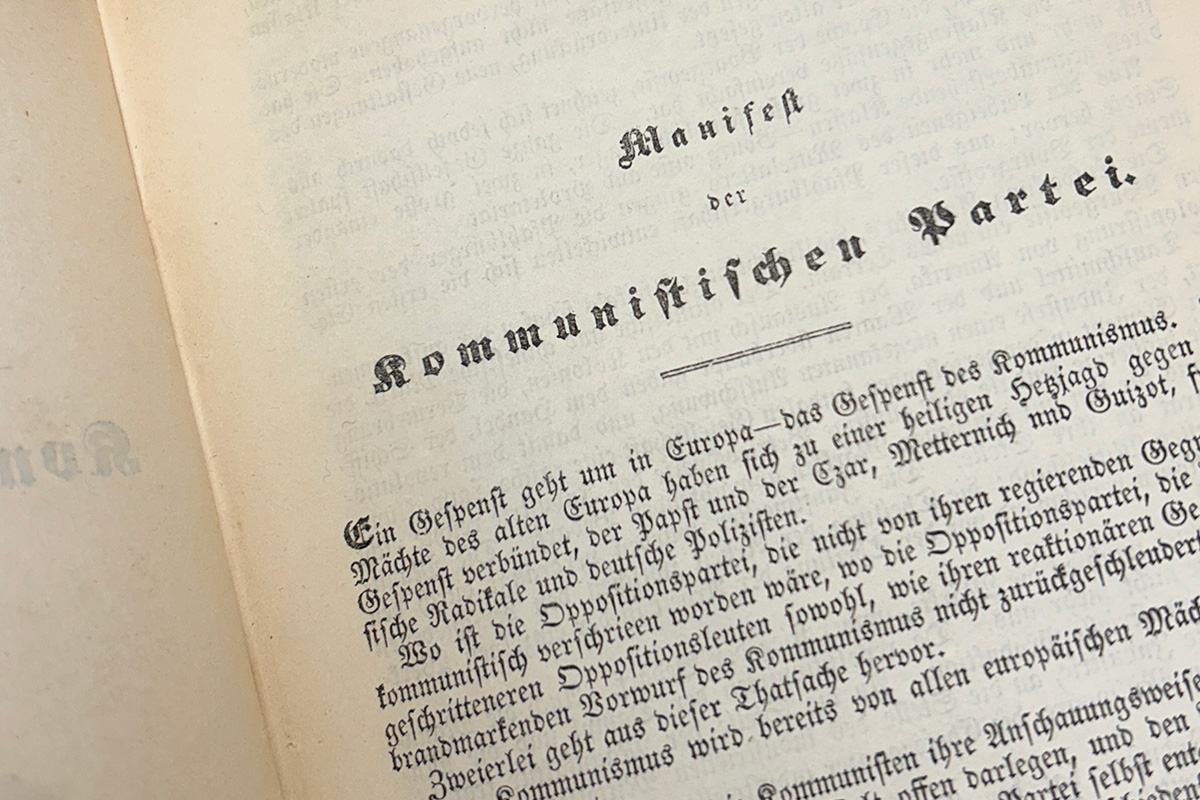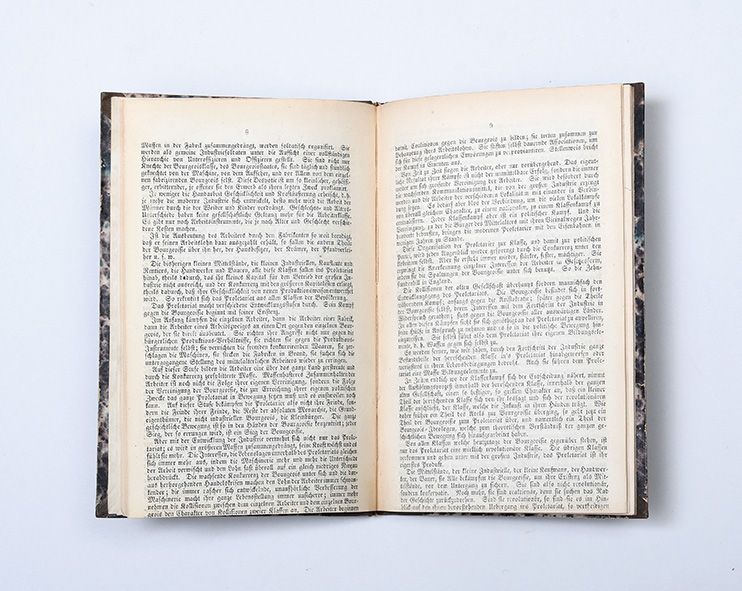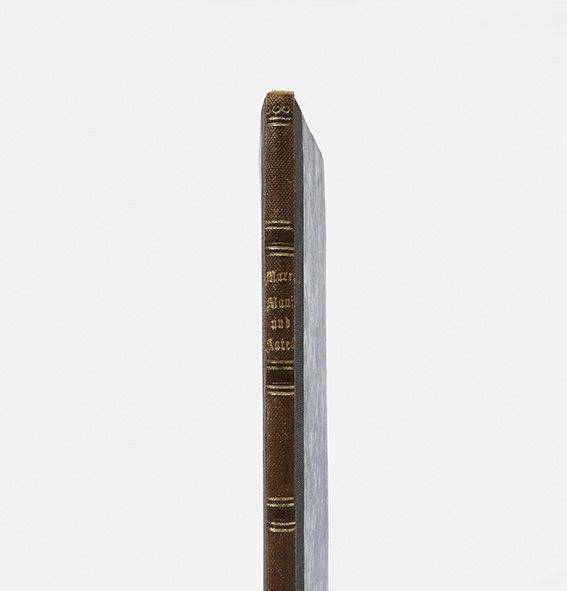The year 1848 was famously a year of revolutions. In February that year, a new political party issued its manifesto. Its famous opening line claimed their nascent movement was a spectre haunting all of Europe. The pamphlet was written in high-flown German but published by an obscure printer at an unfamiliar address in the crowded, impoverished East End of London.
The Pamphlet that Changed the World
Any casual reader picking up this 23-page manifesto could be forgiven for failing to recognize the name of this new political party. The party was to take no part in the astonishing revolutions that swept Europe that spring. While the monarchy was overthrown in France and replaced by a republic, the old leaders in several major German and Italian states and in Austria succumbed to pressure to grant liberal constitutions, and the Italian and German states seemed on the verge of unification, this hitherto-unknown band of would-be revolutionaries remained quiet in London.
And yet, long after the political upheavals of 1848 had subsided, this little pamphlet was to have enormous consequences on the world’s political stage, providing the intellectual firepower behind successful revolutions in Russia, China, Africa, eastern Europe, south-east Asia, and the Caribbean, as well as countless unsuccessful attempts elsewhere. This was, of course, the booklet we now know as the Communist Manifesto.
Karl Marx and Friedrich Engels
In the early 19th century, the word “communist” had come to be used to describe those who supposedly took their political inspiration from the left wing of the Jacobin Club of the French Revolution. One such group of Germans, headed by Karl Schapper, formed a secret society known as the League of the Just (Bund der Gerechten) and took part in a May 1839 rebellion in Paris. After the failure of that uprising, the organization moved to London. Meanwhile, in Brussels, Karl Marx and his close friend and co-thinker Friedrich Engels were part of a small political circle of radical German émigrés called the Communist Correspondence Committee. These groups and others eventually formed a fractious temporary union in the Communist League, which held a London congress in June 1847. At the group’s second congress, held from 27 November to 13 December 1847 at Great Windmill Street in Soho, just off Shaftesbury Avenue, London, Marx and Engels agreed to compose a manifesto for the new organization.
A Truly Rare Book
Writing fast and under pressure from the congress committee, Marx completed the task by the end of February 1848. But on its first publication, perhaps the best-known and certainly the most widely translated pamphlet of the 19th century went almost unnoticed. The first edition was issued in dark green printed paper wrappers, printed on poor quality paper, its text proofread only cursorily and littered with misprints and accidentals. As it was intended to be distributed widely, it had a surprisingly large print run, at least 2,000 copies, and was printed three times in quick succession. Nevertheless, it is now astonishingly rare. Most copies were thrown away or perhaps destroyed for fear of the authorities.
A Truly Rare Book
Writing fast and under pressure from the congress committee, Marx completed the task by the end of February 1848. But on its first publication, perhaps the best-known and certainly the most widely translated pamphlet of the 19th century went almost unnoticed. The first edition was issued in dark green printed paper wrappers, printed on poor quality paper, its text proofread only cursorily and littered with misprints and accidentals. As it was intended to be distributed widely, it had a surprisingly large print run, at least 2,000 copies, and was printed three times in quick succession. Nevertheless, it is now astonishingly rare. Most copies were thrown away or perhaps destroyed for fear of the authorities.
Mysterious Publication
As befits a clandestine operation, the first printing of the Communist Manifesto is clouded in mystery. As there are fewer than 30 copies extant of the first edition of this ramshackle little pamphlet, most with minor variants between them, the scholars have been busy for years debating the bibliographical details, a task complicated by the faulty or self-serving memories of those involved. The publication date is stated on the title page as February 1848, and Marx was always keen to emphasize that the Manifesto was published just before the French Revolution of 1848, which began on 22 February. It wasn’t. Although experts still disagree, the likely range of printing is between 24 February and perhaps as late as the first week of March. On 3 March, serialization of the original version of the text began in the Deutsche Londoner Zeitung. The publisher’s address given on the title page may also be misleading; some claim it was printed in Warren Street, at that newspaper’s offices.
Mysterious Publication
As befits a clandestine operation, the first printing of the Communist Manifesto is clouded in mystery. As there are fewer than 30 copies extant of the first edition of this ramshackle little pamphlet, most with minor variants between them, the scholars have been busy for years debating the bibliographical details, a task complicated by the faulty or self-serving memories of those involved. The publication date is stated on the title page as February 1848, and Marx was always keen to emphasize that the Manifesto was published just before the French Revolution of 1848, which began on 22 February. It wasn’t. Although experts still disagree, the likely range of printing is between 24 February and perhaps as late as the first week of March. On 3 March, serialization of the original version of the text began in the Deutsche Londoner Zeitung. The publisher’s address given on the title page may also be misleading; some claim it was printed in Warren Street, at that newspaper’s offices.
Rare in Commerce and Institutionally
In 1848, existing British copyright law stipulated that a single copy of every book published must be sent for deposit in the Library of the British Museum, at a cost to the publisher of two shillings per entry in the register kept at Stationers’ Hall and one shilling for a certificate to prove registry. Even the major publishers found this obligation irritating, and it was hardly likely that an obscure gang of German agitators would comply. The British Library did not receive a copy on first publication and was only able to acquire a copy as late as 2008. Most of the other great world libraries have no copy in their archives.
Rare in Commerce and Institutionally
In 1848, existing British copyright law stipulated that a single copy of every book published must be sent for deposit in the Library of the British Museum, at a cost to the publisher of two shillings per entry in the register kept at Stationers’ Hall and one shilling for a certificate to prove registry. Even the major publishers found this obligation irritating, and it was hardly likely that an obscure gang of German agitators would comply. The British Library did not receive a copy on first publication and was only able to acquire a copy as late as 2008. Most of the other great world libraries have no copy in their archives.
In April 1848, Marx and Engels found time to correct the text for printing and punctuation mistakes. This revised 30-page version was the basis for future editions of the Manifesto. The original 23-page version had already passed into history.
Written by Adam Douglas, Senior Specialist








